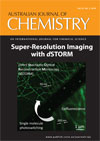
Australian Journal of Chemistry
Volume 67 Number 2 2014
CH13499Focus on Super-Resolution Imaging with Direct Stochastic Optical Reconstruction Microscopy (dSTORM)
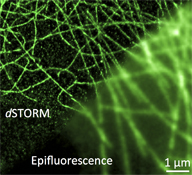
We demonstrate super-resolution microscopy using a home built dSTORM set-up built entirely from ‘off-the-shelf’ components. The cellular skeletal features, actin filaments and microtubules, are imaged with an order of magnitude improved spatial resolution compared with conventional methods.
CH13346Diastereoselective Pictet–Spengler Reactions of a Tethered 2-Aminoimidazole
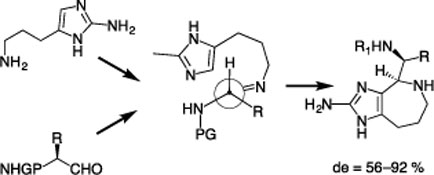
A diastereoselective Pictet–Spengler reaction of 2-aminoimidazoles has been investigated and found to proceed with good to excellent diastereoselectivity, an important first step in stereoselective synthesis of imidazole natural products.
CH13346 Abstract | CH13346 Full Text | CH13346PDF (2.6 MB) | CH13346Supplementary Material (1.6 MB) Open Access Article
CH13194A Series of Imidazolyl-Containing Bisphosphonates with Abundant Hydrogen-Bonding Interactions: Syntheses, Structures, and Bone-Binding Affinity
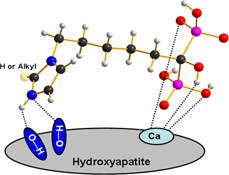
A series of novel bisphosphonates (BPs) with strong hydrogen bonds were designed and synthesised. Bone binding affinities indicated that these five BPs have a strong affinity for hydroxyapatite.
CH13373Probing of the pH-Dependent Redox Mechanism of a Biologically Active Compound, 5,8-Dihydroxynaphthalene-1,4-dione
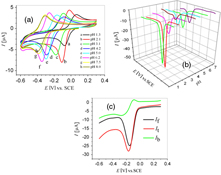
The redox behaviour of a potential anticancer organic compound, 5,8-dihydroxynaphthalene-1,4-dione was investigated using cyclic, differential pulse, and square wave voltammetry. The redox processes were found to occur in a pH-dependent diffusion-controlled manner.
CH13393Decorating Semiconductor Silver-Tetracyanoquinodimethane Nanowires with Silver Nanoparticles from Ionic Liquids
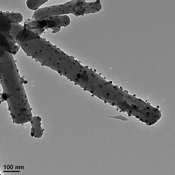
Novel hybrid semiconducting AgTCNQ nanowires decorated with Ag nanoparticles have been prepared via an ionic liquid-assisted solution approach. These hybrid materials made from non-volatile ionic liquid media have the potential to be used in non-volatile memory devices.
CH13355On-Water Reactivity and Regioselectivity of Quinones in C–N Coupling with Amines: Experimental and Theoretical Study
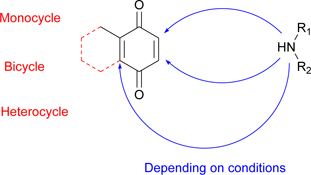
Oxidative coupling of carbo- and heterocyclic non-symmetrical quinones with aryl- and alkylamines was carried out comparing dichloromethane and water as reaction mediums. DFT indexes and electrostatic potential explain the observed chemical reactivity and regioselectivity. On-water conditions were used to obtain 24 new aminoquinones with potential biological activity.
CH13321Synthesis, Characterisation, Interaction with DNA, Cytotoxicity, and Apoptotic Studies of Ruthenium(II) Polypyridyl Complexes
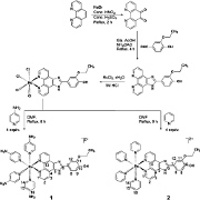
Two new RuII polypyridyl complexes containing monodentate ancillary ligands [Ru(L)44HEPIP], where L = 4-aminopyridine (1) or pyridine (2), and 4HEPIP = 2-(4-hydroxy-3-ethoxyphenyl)-1H-imidazo[4,5-f][1,10](phenanthroline) have been synthesised and characterised. DNA binding, photocleavage, and cytotoxicity studies on different cancer cell lines were carried out. Cellular uptake and apoptosis induced by these complexes was also studied.
CH13372Spectroscopic and Modelling Analysis on the Interaction of 3'-Azidodaunorubicin Semicarbazone with ctDNA
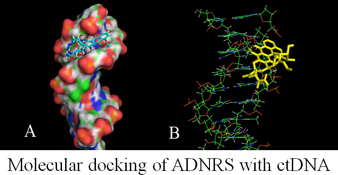
3′-Azidodaunorubicin semicarbazone (ADNRS) interaction with calf thymus DNA was investigated through molecular docking. ADNRS tends to bind with A–T rich base pairs in the minor groove, parallel to the trend of the double helix, through intermolecular hydrogen bonds.
CH13417Syntheses, Crystal Structures, and Properties of Six Coordination Complexes Based on a Newly Designed Mercapto-thiadiazole Ligand
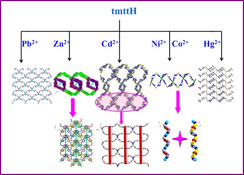
Six new complexes with a range of zero- to three-dimensional frameworks were synthesised successfully by using the flexible triazole and mercapto-thiadiazole-containing ligand. It is quite rare to find that four-fold interpenetrating 3D framework 1 and 2D bilayer motif 2 have one type of helicity.
CH13300Influence of A-site Cation on Structure and Dielectric Properties in A2DyBiO6 (A=Mg, Ca, Sr, Ba) Double Perovskites
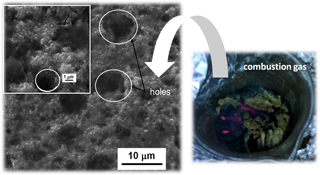
In this paper, we attempt to trace a correlation between structural features and dielectric properties of A2DyBiO6 (A = Mg, Ca, Sr, Ba) double perovskites. These materials were successfully prepared using a sol–gel auto-combustion technique. Relationships between structural features and dielectric properties have been established.
CH13364The Unusual Fluorescence Quenching of Coumarin 314 by β-Cyclodextrin and the Effect of β-Cyclodextrin on its Binding with Calf Thymus DNA
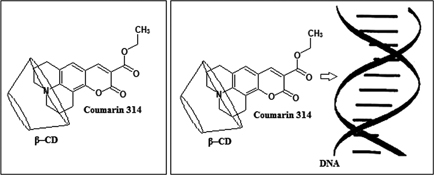
This paper discusses the binding of a laser dye, Coumarin 314 with β-cyclodextrin, studied mainly by UV-visible, 2D ROESY, steady-state and time-resolved fluorescence spectroscopy. The role of β-cyclodextrin on the binding of Coumarin 314 with calf thymus DNA is investigated.
CH13407Quantum-chemical Ab Initio Calculations on the Donor–Acceptor Complex Pyridine–Borabenzene (C5H5N–BC5H5)

Quantum-chemical ab initio and time-dependent DFT calculations were performed to study the structure of, the bonding in, and the UV-vis and IR spectra of donor–acceptor complex pyridine–borabenzene (C5H5B–NC5H5).
CH13426Structure, Thermal Behaviour, and Energetic Properties of 4-Amino-1,2,4-triazole Dinitroguanidine Salt
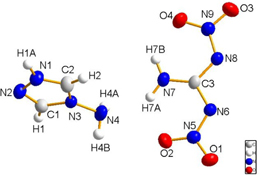
A novel high-nitrogen energetic compound 4-amino-1,2,4-triazole dinitroguanidine salt (4-ATDNG) was synthesized and structurally characterized. The thermal behaviour and the detonation properties results reveal that 4-ATDNG possesses excellent thermal stability and detonation properties, and can be considered as a potential energetic material.
CH13438An Efficient One-pot Two-component Protocol for Regio- and Chemoselective Synthesis of 5-Aryloyl-1,3,7,9-tetraalkyl-2,8-dithioxo-2,3,8,9-tetrahydro-1H-pyrano[2,3-d:6,5-d′]dipyrimidine-4,6(5H,7H)-diones

Novel symmetric fused pyrano[2,3-d]pyrimidine derivatives were synthesized in 75–92 % yield by a one-pot two-component reaction of arylglyoxals and 1,3-dialkyl-2-thiobarbituric acids in ethanol at room temperature. This is the first protocol to be reported for the synthesis of 5-aryloyl-1,3,7,9-tetraalkyl-2,8-dithioxo-2,3,8,9-tetrahydro-1H-pyrano[2,3-d:6,5-d']dipyrimidine-4,6(5H,7H)-diones and the significant features of the present protocol are simplicity, high yields, a simple isolation procedure, and high chemoselectivity.
CH13442Low-temperature Synthesis of Nanocrystalline LiNi0.5Mn1.5O4 and its Application as Cathode Material in High-power Li-ion Batteries
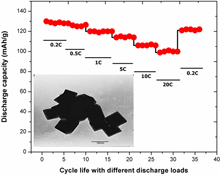
Phase-pure nanocrystalline LiNi0.5Mn1.5O4 was prepared at low temperature by co-precipitation with cyclohexylamine. The low-temperature synthesis prevents the loss of oxygen from the crystal structure, which prevents Jahn–Teller distortion and results in improved stability and electrochemical performance of the product.
CH13382A Simple and Direct Synthesis of 3-Methylene-1, 4-diarylazetidin-2-ones and (E)-3-Arylidene-1-phenylazetidin-2-ones Using Baylis–Hillman Derivatives

A simple and direct method for the synthesis of highly substituted α-methylene β-lactams and α-arylidene β-lactams from the amino ester intermediates derived from the acetates and bromo derivatives of the Baylis–Hillman adducts is described.
CH13458Structural Diversity and Properties of Five 3D Metal–Organic Frameworks Based on a Pyridine-substituted Triazolyl Benzoate Ligand
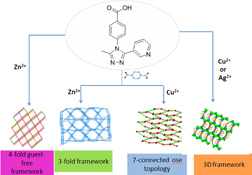
Five new 3D metal–organic frameworks have been synthesized by the reaction of the HL ligand with ZnII, CuII, and Ag I salts. 1 possesses a three-fold interpenetrating framework, 2 is an unusual example of a four-fold framework guest-free metal organic framework material, and 3 reveals a 7-connected ose topology. Photoluminescence measurements of 1, 2, and 5 in the solid state at room temperature show that all coordination networks exhibit red-shift of emission spectra, which can be assigned to an intraligand π–π* transition.
CH13416Halomethyllithium Carbenoids: Versatile Reagents for the Homologation of Electrophilic Carbon Units
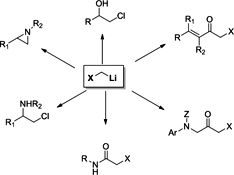
Halomethyllithium carbenoids are useful homologating agents of electrophilic carbon units: a brief overview of their application in synthetic processes is provided.
CH13496Pulsed Gradient Spin-Echo NMR Studies of the Interactions of Platinum Complexes
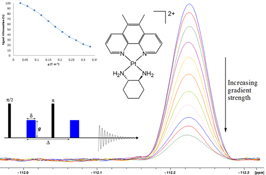
Pulsed gradient spin-echo (PGSE) nuclear magnetic resonance (NMR) has the potential to assist the elucidation of the mechanisms of platinum complexes with potent anticancer activity. However, this technique has rarely seen application to platinum complexes. Recent applications of PGSE NMR to study platinum complex interactions are presented here.



